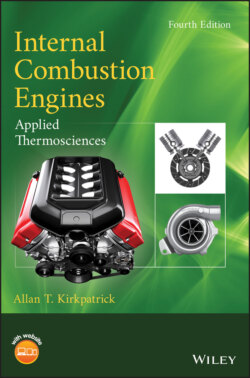Читать книгу Internal Combustion Engines - Allan T. Kirkpatrick - Страница 28
Engine Kinematics
ОглавлениеAssuming a flat piston top, the instantaneous cylinder volume, , at any crank angle is
(1.28)
where is the instantaneous stroke distance from top dead center:
By reference to Figure 1.6
(1.29)
If the instantaneous volume is nondimensionalized by the volume at bottom dead center, , then the nondimensional volume is
(1.30)
We define a nondimensional parameter, , the ratio of the crankshaft radius to the connecting rod length , as
(1.31)
The range of for the slider‐crank geometries used in modern engines is about 0.25 to 0.33.
Therefore, the nondimensional piston displacement is
(1.32)
and the nondimensional cylinder volume is
(1.33)
For , we can expand the term in a Taylor series,
(1.34)
so
(1.35)
As , the approximate volume can then be expressed as a function only of the compression ratio :
(1.36)
The cylinder volumes predicted by Equations (1.33) and (1.36) are compared in Figure 1.11 for a value of , using the Matlab® program Volume.m listed in the Appendix. Both equations give identical results at bottom dead center and top dead center. The approximate volume relation underpredicts the exact cylinder volume by about 18% at 59 degrees near the middle of the stroke.
Figure 1.11 Cylinder volume vs. crank angle for (Equations 1.33 and 1.36).
The instantaneous piston velocity can be found by replacing with and differentiating Equation (1.32) with respect to time giving
(1.37)
Equation (1.37) can be nondimensionalized by the mean piston speed , resulting in
(1.38)
Using the Matlab® program Velocity.m listed in the Appendix, the nondimensional velocity is plotted versus crank angle from top dead center (tdc) to bottom dead center (bdc) in Figure 1.12 for a value of . The piston velocity is zero at tdc and bdc. Due to the geometry of the slider crank mechanism, the velocity profile is nonsymmetric. For this example, the maximum nondimensional velocity = 1.65 occurs at = 72 after tdc.
Figure 1.12 Nondimensional velocity vs. crank angle for (Equation 1.38).
If we neglect terms of , and use the trigonometric identity , the piston velocity can be approximated as
(1.39)
The acceleration is found by differentiating Equation (1.39) with respect to time
(1.40)
Note that the velocity and acceleration terms have two components, one varying with the same frequency as the crankshaft, known as the primary term, and the other varying at twice the crankshaft frequency , known as the secondary term. In the limit of an infinitely long connecting rod, i.e., , the motion reduces to a simple harmonic at a frequency .
The reciprocating motion of the connecting rod and piston creates accelerations and thus inertial forces and moments that need to be considered in the choice of an engine configuration. In multicylinder engines, the cylinder arrangement and firing order are chosen to minimize the primary and secondary forces and moments. Complete cancellation is possible for the following four‐stroke engines: in‐line 6‐ and 8‐cylinder engines; horizontally opposed 8‐ and 12‐cylinder engines, and 12‐ and 16‐cylinder V engines (Taylor 1985).
